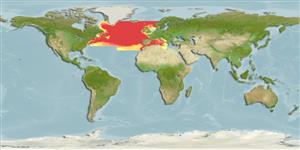Environment: milieu / climate zone / depth range / distribution range
Ökologie
seewasser bathypelagisch; ozeanodrom; tiefenbereich 50 - 1032 m (Ref. 56504), usually 200 - 600 m (Ref. 35388). Deep-water; 65°N - 30°N, 77°W - 21°E
Atlantic Ocean: restricted to the North Atlantic and adjacent seas.
Size / Gewicht / Alter
Maturity: Lm ? range ? - ? cm
Max length : 50.0 cm SL Männchen/unbestimmt; (Ref. 35388)
Depth range from 50-1000 m (ref. 04473) and up to 1032 m in the eastern Ionian Sea (Ref. 56504). Epipelagic to bathypelagic (Ref. 58426); also mesopelagic (Ref. 5951). Feeds on fishes, crustaceans and occasionally planktonic organisms (Ref. 5759). Spawns from March to September, larvae near the surface (Ref. 35388).
Life cycle and mating behavior
Maturities | Fortpflanzung | Spawnings | Egg(s) | Fecundities | Larven
Larvae are found near the surface.
Post, A., 1990. Paralepididae. p. 373-384. In J.C. Quero, J.C. Hureau, C. Karrer, A. Post and L. Saldanha (eds.) Check-list of the fishes of the eastern tropical Atlantic (CLOFETA). JNICT, Lisbon; SEI, Paris; and UNESCO, Paris. Vol. 1. (Ref. 4473)
IUCN Rote Liste Status (Ref. 130435)
Bedrohung für Menschen
Harmless
Nutzung durch Menschen
Fischereien: nicht kommerziell
Tools
Zusatzinformationen
Download XML
Internet Quellen
Estimates based on models
Preferred temperature (Ref.
123201): 2.2 - 14, mean 7.4 °C (based on 462 cells).
Phylogenetic diversity index (Ref.
82804): PD
50 = 0.5625 [Uniqueness, from 0.5 = low to 2.0 = high].
Bayesian length-weight: a=0.00224 (0.00090 - 0.00555), b=3.14 (2.92 - 3.36), in cm total length, based on LWR estimates for this (Sub)family-body shape (Ref.
93245).
Trophic level (Ref.
69278): 4.1 ±0.70 se; based on food items.
Fishing Vulnerability (Ref.
59153): Moderate vulnerability (44 of 100).
Nutrients (Ref.
124155): Calcium = 30.6 [9.3, 91.7] mg/100g; Iron = 0.35 [0.11, 1.10] mg/100g; Protein = 16.2 [13.1, 18.8] %; Omega3 = 0.105 [0.028, 0.323] g/100g; Selenium = 21.1 [6.3, 65.8] μg/100g; VitaminA = 11.8 [1.2, 92.8] μg/100g; Zinc = 0.442 [0.227, 0.867] mg/100g (wet weight);
